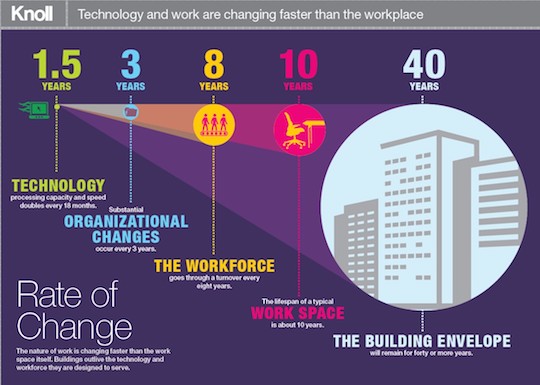How flexible is your work space? Whether your environment is a corporate office, a health care center, or educational facility, the layouts and designs of the 20th century are not so workable in the 21st.

Take technology, for example. The Knoll “Rate of Change” graphic makes it clear that our technology processing capacity and speed doubles every 18 months.
Are you sitting in a building or furniture that was designed for the work of the 90’s? Was your desk designed before computers were used? Maybe it has a large corner surface for those enormous monitors we used prior to flat screens. Today, every desk has a computer that is smaller than a microwave oven – often a laptop that can go with you wherever you decide to work. While we may never be 100% paperless, filing and storage needs have drastically reduced. Fax machines are a distant memory for most of us. Rooms designated specifically for storage and filing are becoming obsolete and finding new, but not necessarily efficient uses.
We have no clear idea of how technology will change in the next two years, much less 30. Yet creating a flexible design today can save time and money in the future.
We must question whether things we consider essential today will still be essential in 2, 5 or 10 years. As we construct new buildings that won’t have major changes for 40 years, we need to think about how we can design them with flexibility. To have things we consider essential built in permanently won’t necessarily work for the technology of 10-20 years in the future. This is especially true because many businesses update their technology every 18-36 months. The workforce, too, generally turns over every 8 years.
What’s Changing?
We need more power outlets today than we did two decades ago, and charging our computers and phones is an important consideration. We don’t want to be crawling under desks to plug in. Today, a “charging pad” that works anywhere you put it is an innovation. But will we need them a decade from now, or is there likely to be a new technology placed in the ceiling that will automatically charge every phone in the building?
If you are having a building constructed, or looking for space in an existing building, consider asking your builder or leasing agent a few questions:
- Are the building walls, power outlets, and furniture fixed in place and not easily moved?
- Are WIFI and power access points easily accessed from multiple places within the space?
- Is there parking for alternative power vehicles?
- To meet their changing needs, can the furniture easily moved by the occupant?
Flexible Office Space: Taking you Into the Future
Technology, the workforce, and an organization as a whole change in predictable cycles. The buildings in which they function, however, stay pretty stagnant for up to 40 years or more. It’s important, when considering a new space, to have a clear vision of what you might need today. Yet you also need to plan for flexible office space into the future.






